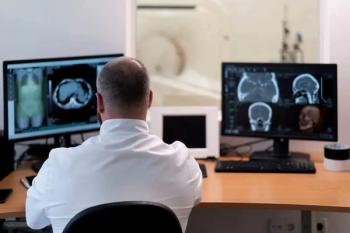
Radiology’s Ethical Dilemmas in the Age of COVID-19
The viral outbreak presents new challenges and tests of conscience.
Picture it – you’ve been called in to complete a CT scan that will provide an update on the condition of a patient who has tested positive for COVID-19. But, you have a family member at home who has chronic pulmonary disease, as well as a compromised immune system. Getting that close to an infected person could mean you’ll put your loved one at risk.
What do you do?
The answer isn’t an easy one, Richard Gunderman, M.D, Ph.D., Chancellor’s professor of radiology, pediatrics, medical education, philosophy, liberal arts, philanthropy, and medical humanities and health studies at Indiana University, told Diagnostic Imaging.
“As a radiologist or radiation oncologist or radiologic technologist, you’ll likely be called to help care for a patient who is either positive for the virus or suspected of the virus,” he said, discussing his article published this week in the
And, with the level of precautions needed to protect radiologists and other providers as they deliver care to patients with viral infection, it’s important for you, as radiologists, to understand what your ethical and professional responsibilities are and how to navigate any grey areas.
The Challenges & Responsibilities That Exist
In this outbreak, your biggest responsibility and challenge are virtually one and the same, Gunderman said. You have a professional obligation to provide care for any reasonable request when you are called upon to do so, but that also means you’ll assume a higher level of risk than usual.
“There’s an assumption of risk for a technologist who takes an X-ray or a radiologist who performs an ultrasound for a patient with a known contagious respiratory infection,” he said. “But, this is an issue of stepping up to the plate and making sure the patient gets care unless there’s a clear reason not to.”
There are some instances, though, when providing care and exhausting resources isn’t the most ethical course of action. For example, he said, if there’s almost no chance that a patient will receive any benefit from a medical intervention – and you’re almost guaranteed you’ll either expose yourself or your colleagues to possible infection – forgoing care is your best option.
“As a radiologist, do you go to the intensive care unit to drain a fluid collection or perform a biopsy on a patient if there’s no chance of it improving their condition?” he asked. “You have an ethical responsibility to be sure you’re not putting yourself or others in harm’s way.”
What You Should Do
Above all else, Gunderman said, radiologists bear the responsibility of being good leaders and role models.
“We should neither be engaged in reckless abandon nor cowardice. We shouldn’t just throw caution to the wind,” he said. “And, at the same time, we shouldn’t put our own self-protection or self-preservation above all other concerns.”
To not approach a patient care situation with the appropriate level of seriousness or dedication could ultimately undermine the respect and trust afforded to you by your colleagues.
It’s also important that you be willing to assume the same level of risk as your colleagues. While it’s possible for you to work from home frequently, when you are in the hospital, work within the same protective measures – gloves and masks – as everyone else, he said.
“I don’t think we should expect a higher degree of safety or comfort for ourselves than we’re expecting our colleagues to endure,” he said. “That doesn’t mean that every radiologist has to be in the hospital, face-to-face with patients every day. But, we should be mindful that our colleagues and other medical specialties may be faced with patients every day.”
Facing an Ethical Dilemma
With the rapidly changing nature of the COVID-19 pandemic, it’s impossible to predict when you’ll find yourself faced with a situation that might test your ethical resolve. And, it’s equally as impossible to know exactly what you should – or would – do beforehand, Gunderman cautioned.
“Nobody has a 3x5 card or a list of five simple rules to follow to make sure they’re handling ethical challenges correctly,” he said. “We’re in realm of ethics, and each case is, to some degree, distinct.”
But, there are strategies you can use to navigate the situations that pop up that make you question whether you know the right thing to do. Alongside making sure you preserve the autonomy of the patient and provide all the services that can benefit the patient, Gunderman pointed to more personal tactics.
First, he said, in high-stake situations where the appropriate actions might be unclear, think of a radiologist or radiologic professional you hold in high regard.
“Consider what they would do in whatever situation you’re facing,” he suggested. “In many ways, that can provide reliable guidance.”
In addition, calling a colleague for advice or simply to discuss the situation can be an effective way to flesh out your options and point you down the most ethical path.
Ultimately, Gunderman said, you and your co-workers will need to determine how to face ethical dilemmas based on your own conscience and the specific characteristics of each situation.
“We need to be mindful of the fact that an excellent radiologist isn’t just defined by his or her fund of knowledge or ability to detect lesions or technical proficiency in performing procedures,” he said. “Excellence in radiology is a matter of character, and in times of trial, that character most clearly reveals itself. We must exhibit and embody excellence in character, as well as knowledge and skill in our work as radiologists.”
Newsletter
Stay at the forefront of radiology with the Diagnostic Imaging newsletter, delivering the latest news, clinical insights, and imaging advancements for today’s radiologists.






























